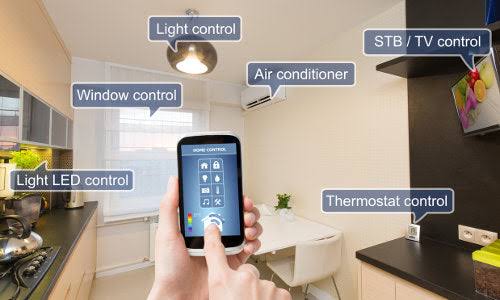Discover how smartphones enhance home security and automation by offering real-time monitoring, remote control, and energy efficiency. Learn about the benefits of centralized control, improved accessibility, and advanced safety features that make managing your home easier and more secure.
In modern era smartphones have become central to daily lives, offering unprecedented convenience and connectivity. One area where smartphones made significant impact is in home security and automation. By leveraging power of smartphones homeowners can enhance security systems. They can also automate various aspects of homes. This leads to increased safety, efficiency and convenience. This article explores numerous benefits of using smartphones for home security and automation
Enhanced Security Monitoring
One primary advantage of integrating smartphones with home security systems is ability to monitor property remotely. Modern security systems often come with smartphone apps. These apps allow homeowners to view live video feeds from security cameras. They also receive real-time alerts and check status of security systems from anywhere in world.
1. Real-Time Alerts: Smartphones enable users to receive instant notifications about any suspicious activities or security breaches. Whether it's motion detected by camera or door being opened homeowners can act quickly to address potential threats.
2. Live Video Streaming: Many security systems offer live video streaming through smartphone apps. This allows homeowners to view footage from security cameras in real time. This feature is particularly useful for checking in on home while away. It’s beneficial whether you are on vacation or at work.
3. Remote Control: Smartphones provide remote access to security devices. Users can arm or disarm their systems. They can lock or unlock doors and control security cameras from distance. This remote control capability ensures homeowners can manage security systems even when not physically present
Convenience and Integration
Smartphones facilitate integration of various home automation systems making it easier to control and manage different aspects of your home from single device. This level of convenience streamlines daily routines. It enhances overall user experience.
1. Centralized Control: With smartphone, homeowners can control multiple smart devices and systems from single app. This centralized control eliminates need for multiple remotes or switches. It simplifies management of home automation systems.
2. Automation Routines: Smartphones enable creation of automation routines that perform tasks based on specific triggers or schedules. For example you can set up routine that turns off all lights and adjusts thermostat when you leave house. Or one that turns on lights and starts coffee maker when you wake up.
3. Voice Control: Many home automation systems are compatible with voice assistants such as Amazon Alexa, Google Assistant or Apple Siri. By using voice commands through your smartphone, you can control smart devices. Check security system status and execute automation routines hands-free.
Energy Efficiency
Smartphones contribute to energy efficiency by allowing homeowners to manage and optimize energy usage. Through smartphone apps users control smart thermostats, lighting systems and other energy-consuming devices. This leads to potential cost savings and a reduced environmental footprint.
1. Smart Thermostats: Smartphones enable users to control smart thermostats remotely. This allows them to adjust heating and cooling settings based on preferences and schedule. For instance you can lower thermostat while away from home. Then raise it just before returning, ensuring comfortable environment while saving energy.
2. Lighting Control: Smart lighting systems controlled via smartphones allow users to turn lights on or off remotely. They can set schedules and adjust brightness levels. By using these features homeowners reduce energy consumption ensuring that lights are only on when needed.
3. Energy Monitoring: Some smart home systems provide energy monitoring features that track and analyze energy usage patterns. Through smartphone apps, users access detailed reports and insights. This helps them identify areas where they can make energy-saving adjustments.
Improved Accessibility
Smartphones enhance accessibility for individuals with disabilities or mobility challenges by providing remote control and automation options that make everyday tasks easier and more manageable
1. Remote Access: For individuals with mobility issues smartphones offer way to control home security and automation systems without need to physically interact with switches or panels. This remote access allows for greater independence. It provides convenience in managing home environments
2. Customizable Alerts: Smartphones enable customization of alerts and notifications, which can be tailored to suit individual needs. For example visual alerts or vibrating notifications can be set up to assist individuals with hearing impairments in receiving important security updates
3. Integration with Assistive Technologies: Smartphones can integrate with various assistive technologies, such as smart doorbells with video capabilities and voice-controlled devices to provide more accessible and inclusive home environment
Enhanced Safety Features
Smartphones contribute to overall home safety by integrating advanced features and technologies that help prevent accidents and respond to emergencies
1. Smoke and Carbon Monoxide Detectors: Many modern home security systems include smart smoke and carbon monoxide detectors. These send alerts to your smartphone in case of emergency. This early warning allows for swift response improving safety for all household members
2. Emergency Response: Smartphones can be used to quickly contact emergency services or alert neighbors in case of security breach or other urgent situations. Some home security systems offer built-in emergency response features that connect directly to local authorities or monitoring centers
3. Access Control: Smartphones can be used to manage access to your home through smart locks and doorbell cameras. By using your smartphone to grant or deny access to visitors you can enhance security and control who enters your home
Conclusion
The integration of smartphones with home security and automation systems offers numerous benefits including enhanced security monitoring convenience, energy efficiency improved accessibility and advanced safety features. By leveraging capabilities of smartphones, homeowners can create a more secure environment. They can also make it efficient and user-friendly. As technology continues to evolve potential for further advancements in smartphone-driven home security and automation will likely enhance benefits even more. This will provide greater peace of mind and convenience for homeowners.
